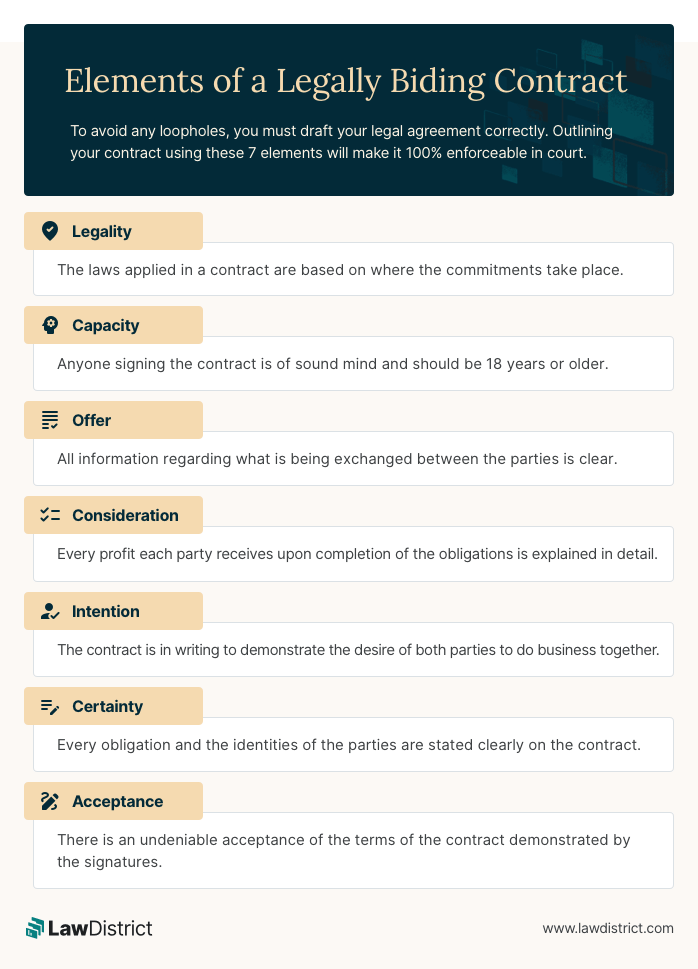Like any legal document, a contract has to be carefully crafted to make sure it conforms with the law. Missing any of the 7 key elements of valid contracts can lead to issues getting people to follow your agreement or to enforce the document in the courts.
Getting your contract right is your primary goal when committing to an agreement. Therefore, understanding these 7 elements is essential when you write your own.
When planning how to make a contract legal you’ll need to make sure your document conforms to these critical needs. We look over how these work in practice below.

Legality: What Laws Will Apply?
One of the first and most important starting points for any contract is deciding which laws will apply. Every state has different laws and ways of handling disputes between contracted parties. This will naturally have a big impact on how it may be enforced and how it must be written.
Usually, you would create and sign a contract based on where the proposed obligations are taking place. This guarantees that the business being done is properly protected by the most suitable and local contract law.
Capacity: Are the Parties Fit to Enter an Agreement?
Another major factor in a contract is whether the parties are fully fit to understand and accept the responsibilities of the proposed agreement. At the very least, this means that the people signing must be sound of mind, over 18 years of age, and not intoxicated or unconscious.
However, there is another element to this. As contracts are often signed by individuals on behalf of companies, it is essential that the person signing has the correct authority to sign agreements for their employer, principal, or client.
Therefore make sure that anyone signing as a representative for a person or company has the right permission to do so. This might be via a valid Power of Attorney or by having a person of sufficient seniority within an enterprise sign the final agreement.
Offer: What Is Being Proposed?
A contract needs to show that there is a proposal or promise made between the parties named on the paper. This will outline what is being exchanged and how.
When you write a contract yourself you’ll need to show details that adequately explain the nature of the offer. Use the following checklist to make sure your agreement correctly shows this by explaining:
- What product or service is being exchanged.
- How and when will it be exchanged?
- The costs of this exchange.
- Who is responsible for what in this transaction?
- What will happen if someone doesn’t fulfill their obligations?
These need to be sufficiently detailed. This makes sure everyone knows what they are agreeing to so there can be no misunderstandings or issues when the exchange occurs in real life.
Consideration: What’s in it For You and the Other Parties?
Legal consideration is another crucial part of any contract. This allows anyone reading the agreement to see what benefits each party will receive from taking part in it.
In legal terms, a contract cannot be considered valid if no consideration exists. Instead, it would imply the agreement was operating on a voluntary basis and therefore parties would have no rights to legal recourse if an obligation isn’t carried out.
Therefore you have to clearly show on paper what each party is getting from the contract. For example, it might be money, the use of a service, an asset, or another item of value.
However, there are some legal documents that will bind parties to a promise that can operate without consideration. Deeds are probably the best example of this as they commit two parties to a transfer in property ownership but do not require money to change hands to be valid.
Intention: Are the Parties Interested in Partnering Together?
Intention (also known as mutuality) means that there is a clear sign the parties wish to do business together. Therefore a legally binding contract must also show that the exchange that all the parties named have consented to the transaction.
In business, this is usually easy to prove given that companies aren’t usually in the habit of exchanging goods and services for free. With informal agreements between friends and family members this can be trickier as there isn’t the same presumption of a transaction in this context.
However, the most secure way to prove intention is to put the contract in writing. This commits your agreement to paper, allowing a record to be kept of the terms that have been approved.
Certainty: Is the Contract Clear?
To avoid a breach of contract for either party the agreement must create certainty of its essential terms.
This refers to the commitments listed on paper that are integral to the functioning of the contract. For instance, the description of the services or goods being provided by each party.
Furthermore, the contract must clearly identify its key parties. Not doing so may lead to a lack of privity. This simply means that it may only be enforced by or against parties named on the document.
Acceptance: Does Everyone Agree?
Last but not least, it is important that the contract shows a clear acceptance of the terms from the parties involved. This is highly important as being unable to prove mutual assent could make the document unenforceable.
Usually, acceptance is shown with the signatures of the parties. However, when a contract isn’t formally written it might be demonstrated by one or more of the signees abiding by their contractual obligations.
Writing a contract isn’t a difficult task but it is one that requires care. As long as you include the 7 features listed above in some capacity you can have faith that your written agreement will be legally binding and properly protected when it is put into action.
Related Articles:
Pros and Cons of Prenuptial Agreements



